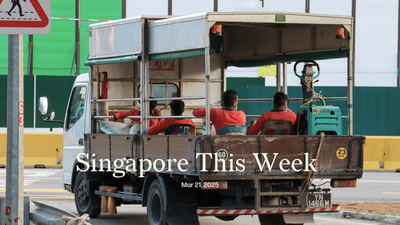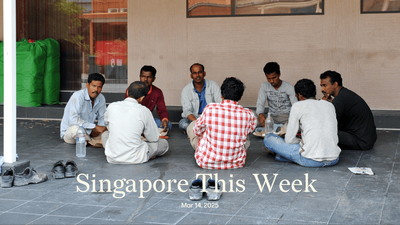International: Singapore, the arms trading hub?
Burmese generals; Russian arms smugglers; and North Korean nuclear weapon builders. They are all indebted to Singapore’s open port and financial networks, according to (various) allegations by the US and the UN. The latest report last week, by Tom Andrews, a UN special rapporteur, said that since the February 2021 coup in Myanmar, some US$254m (S$343m) of “critical supplies”, including arms, spare parts, manufacturing equipment and raw materials, have been shipped to the Myanmar military by scores of Singapore-based entities. Andrews privately named over 45 of them to the Singapore government, and said that Singaporean banks were used “extensively” by arms dealers. A carefully worded reply by the Ministry of Foreign Affairs (MFA) said that Singapore will examine “whether any offences were committed under Singapore law.” Though Singapore itself hasn’t sold arms to Myanmar for “a very long time”, according to Vivian Balakrishnan, the foreign affairs minister, it’s unclear what loopholes private companies domiciled here might exploit. It’s analogous to a US Treasury report in February this year that imposed “full blocking sanctions” against Serena Ng Bee Lin, a Singaporean, and Asia Trading & Construction, a Singapore-based firm, for their involvement in a Russian arms network. MFA’s tepid response said that individuals and entities should “familiarise themselves with sanctions imposed by foreign countries.” Again, though Singapore imposed financial sanctions and export controls on Russia in March 2022, it’s unclear if Ng broke any local law. Singapore’s reputation as a free port has been cultivated over some 200 years. “Singapore is a tiny city-state. Our trade is more than three times our GDP. When we say we believe in free trade, it is not a debating point, it is lifeblood,” Balakrishnan said last year. As Singaporeans become more concerned about our role in facilitating illicit or unethical flows of goods, services and money, international trade and capital flows may have to become a little less free.
Society: Caregivers need care too
Last Saturday, the Agency for Integrated Care (AIC) launched “We See You Care”, a campaign targeted at caregivers, which consolidates resources related to financial grants, support groups and respite care. The campaign also aims to recognise the important (and often invisible) role played by caregivers in our ageing society, as well as raise awareness about caregiver burnout. “You spend so much time taking care of a person, that you don’t realise you’re losing yourself at the end of it. It’s a very scary thing,” Warren Sheldon Humphries, who cares for an elderly relative, told The Straits Times. One reason for caregiver burnout could be the fact that many do not even identify as such—less than half of those with at least one dependent do, according to a 2021 AIC survey. This makes them vulnerable to neglecting their own needs or resistant to asking for help. Last year, the National Council of Social Service found more than half of their survey respondents were “burdened” or “barely coping” with their caregiving responsibilities. This is worrisome considering that as our society ages, so do our caregivers. To assuage this, the Ministry of Health is working closely with AIC to support caregivers via community outreach teams that conduct health and wellness activities. Other organisations, such as Silver Caregivers Co-operative Limited, also provide caregiver training that covers both physical skills (like handling medication) and emotional skills (stress management and communication strategies). There are also initiatives to offer better financial support for lower-income families, such as doubling the Home Caregiving Grant to S$400 a month. “An ageing population will totally change the way our society works…[and] our country is not just ageing, but ageing rapidly”, warned Lee Hsien Loong, prime minister, back in April. By 2030, one in four Singaporeans will be over 65. As we face the challenges of an ageing population, let’s remember to show appreciation to the caregivers in our community—including those who don’t even realise they’re one.
Society: Improving workplace safety and health for our most vulnerable
After a disastrous year for workplace-related fatalities and injuries in 2022, the Ministry of Manpower (MOM) has introduced new Safety Accountability, Focus and Empowerment (SAFE) measures to further improve workplace safety and health (WSH). Besides reducing deaths and accidents, these initiatives aim to strengthen ownership of WSH practices at sectoral, company and worker levels. For one, the demerit points system for WSH breaches will be extended from construction to manufacturing, the worst-performing sector during the heighted safety period—at a major injury and fatality rate of 39.3 per 100,000 workers. Companies that accumulate 25 demerit points or more within an 18-month period will be temporarily banned from hiring foreign workers. Construction sites with high-risk work activities and a project value of S$5m or more will have to set up video surveillance systems used to deter unsafe behaviour, identify WSH risks and facilitate investigations into accidents. There will also be more stringent safety requirements in the tendering process for government projects. CEOs and board directors of all companies in higher-risk industries will be required to attend the new Top Executive WSH Programme. Business leaders will also be held accountable to MOM for serious WSH lapses, and be directly responsible for implementing rectifications. Workers will be prodded to report unsafe practices to employers, union leaders or MOM. The national “Reporting Saves Lives” campaign encourages companies to set up an internal reporting framework to “build a culture of trust”, and where “everyone watches out for one another”. In May last year, Lee Hsien Loong, prime minister, called the spate of workplace fatalities “far too many” and “not acceptable”. (The Migrant Worker Death Map shows 455 reported deaths from 2000 to 2022 that includes, but isn’t limited to, workplace-related fatalities.) All these initiatives are important—though it’s the rigorous enforcement of them that will help temper the power dynamic between companies and low-wage foreign workers.
Arts: Andrew Gn
Paris-based Singaporean fashion designer Andrew Gn’s first retrospective will show at the Asian Civilisations Museum (ACM) this month. Gn is one of Singapore’s most internationally successful fashion designers and has clothed celebrities like Emma Stone, Jennifer Lopez, and Lady Gaga on the red carpet and the silver screen. The exhibition will draw from over 160 pieces donated by the designer and will feature his signature use of Asian motifs and techniques—some of which can be seen in the museum’s own collection. Over the past 28 years, his designs have taken inspiration from Chinese porcelain, Indian textiles and Malay dye techniques like batik and ikat. ACM has featured contemporary Singaporean fashion increasingly in the past few years, like the #SGFASHIONNOW showcase—held twice already, hopefully it becomes an annual. But this marks the first time they will dedicate an exhibition this large to a single designer’s oeuvre. “Andrew Gn: Fashioning Singapore and the World” runs from May 27th to September 17th. For more information, visit the museum’s website.
Arts: An art-inspired orchestral composition
Cultural Medallion recipient Kelly Tang will premiere his new composition this year at the Esplanade Concert Hall. Titled “Movements in Time”, the suite for orchestra takes inspiration from artworks in the National Gallery Singapore, like those by fellow Cultural Medallion recipients Chua Mia Tee, Sarkasi Said (aka Tzee) and Han Sai Por. The work will be performed by the Metropolitan Festival Orchestra, Singapore’s fully independent professional symphony orchestra, and is funded by the Foundation for the Arts and Social Enterprise. The Foundation is a relatively new player in the Singaporean art scene and describes itself as a "venture capitalist in the arts space”. Movements in Time is part of The Foundation’s Music Commissioning Series that aims to fund new Singaporean compositions over a period of 10 years. The Foundation received IPC (Institution of Public Character) status in 2019 and is aiming to raise S$10m over the next five years to support its projects, many of which are still in development. Find more information about The Foundation on its website. Tickets for Movements in Time are available via Sistic, performing on June 24th at both 2.30pm and 7.30pm.
History weekly by Faris Joraimi
Singaporean actor Wahid Satay passed away on Monday, aged 93. Born Abdul Wahid Bin Ahmad in Dutch Sumatra, the star of golden-age Malay cinema earned his stage name from a memorable role as a satay man in the 1957 Cathay-Keris blockbuster “Pontianak”. The horror flick had cross-cultural appeal, with the late Wahid as comic relief. He had been a sailor before joining Singapore’s then-thriving movie industry as a studio-set painter at Cathay-Keris’s East Coast Road lots, later landing roles on the silver screen. Physical comedy was his talent in a career spanning over 30 films. My favourite Wahid Satay scene, from watching these old Malayan movies growing up—and how truly Malayan, with Chinese and Indian labour and capital behind the scenes—is from “Sultan Mahmud Mangkat Dijulang” (1961). It tells the story of Mahmud II, a king of Johor assassinated in 1699, mentioned in both European and Malay accounts. Wahid played a palace gardener who sang a traditional Malay nursery rhyme, “Bangau oh Bangau” (Egret, oh Egret), describing how plants, animals and humans are interdependent in nature’s web. Staying in Cathay-Keris’s signature historical dramas, Wahid performed the title role in “Badang” (1963), based on the super-strong figure of ancient Singapura mentioned in Johor chronicles. Through his performances, Wahid not only participated in an important era of Singaporean and Malaysian entertainment history; he also helped tell our shared history, the records of Malay scribes brought to life in celluloid motion. When the studios stopped making movies, Wahid found other jobs—swimming pool attendant, carpenter—before his children made him retire. I met him in person twice with my late grandmother, who as a playback singer for the movies, was a lifelong friend of “Enche’ Wahid”. Long may his work be remembered.
Tech: Amazon/Atome takes on Lazada and Shopee with buy now, pay later
Amazon has expanded its payment offerings in Singapore by introducing a buy now, pay later (BNPL) option through a strategic partnership with local fintech firm Atome. This move is set to bolster Amazon’s competitive position in the city-state where it faces stiff rivalry from popular e-commerce platforms Shopee and Lazada. It also marks Amazon’s first BNPL partnership in South-east Asia. Currently, established e-commerce platforms such as Shopee and Lazada, ride-hailing platforms such as Grab and GoJek, and tech firms like Sea, are offering their customers short-term loans to help them pay for a variety of products and services, including taxis, food delivery and beauty products. It was only a matter of time before Amazon had to provide a pay later offering to make the customer experience competitive on its platform. The choice of Atome, which has won approval from the Monetary Authority of Singapore to offer regulated payment services, as a partner isn’t surprising. Last year, it secured a US$100m (S$134m) debt facility with HSBC Singapore and raised US$80m (S$107m) in equity financing recently, reflecting its strong financial position. Its parent company, Advance Intelligence Group, has over 500 enterprise clients, 235,000 merchants, and 40 million individual consumers across Asia-Pacific. The group has disbursed over US$4bn (S$5.4bn) in loans since its inception in 2016. Last year, Atome collaborated with the Singapore Fintech Association and other industry players, including Grab and Shopback, to develop a code of conduct for BNPL providers. It outlines industry-agreed standards and safeguards to mitigate the risk of debt accumulation and protect the interests of BNPL users, and went into effect last November. Amazon clearly deliberated who would be the strongest and most reliable player here to partner with as it takes on the local e-commerce giants in Southeast Asia. Yet, can a new pay later option move the needle on its sales or will it only defend from attrition?
Tech: Grab’s push for profitability gathers speed
Your rising fares and fewer discount codes have contributed to another solid quarter for Grab. In Q1 2023, it recorded a remarkable year-on-year revenue growth of 130 percent, reaching US$525m (S$706m), and surpassing the consensus expectation of US$505m (S$658m). This highlights the company’s ability to significantly improve its profitability while maintaining its customer base. A key indicator of Grab’s progress towards profitability is the 43 percent reduction in losses for the period, which dropped from US$425m (S$571m) in the previous Q1 2022 to US$250m (S$336m) in Q1 2023. This suggests that the company’s efforts to streamline operations and improve cost management are beginning to pay off. In terms of gross merchandise volume (GMV) growth, most segments saw a decline of 9-21 percent. While overall GMV grew by a modest three percent to reach US$4.96bn (S$6.67bn), this could be attributed to the mobility segment’s growth of 46 percent, showcasing a resurgence in demand for transportation services. If GMV did not grow significantly, how did Grab increase its revenue significantly? Grab has attributed it mainly to contributions from Jaya Grocer and a reduction in incentives. Ultimately, Grab’s latest Q1 2023 earnings report presents a robust push towards the previously stated target of achieving group adjusted EBITDA breakeven in Q4 2023. Guess the pricier rides are here to stay.
If you enjoy Jom’s work, do get a paid subscription today to support independent journalism in Singapore.








